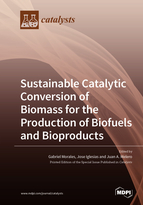Sustainable Catalytic Conversion of Biomass for the Production of Biofuels and Bioproducts
A special issue of Catalysts (ISSN 2073-4344). This special issue belongs to the section "Biomass Catalysis".
Deadline for manuscript submissions: closed (31 December 2019) | Viewed by 48304
Special Issue Editors
Interests: catalysis; bioproducts; biofuels; biomass conversion
Interests: heterogeneous catalysis; biomass valorisation; platform molecules; bioproducts; zeolites and zeolitic materials; mesoporous materials
Special Issue Information
Dear Colleagues,
Biomass is widely considered a potential alternative to dwindling fossil fuel reserves. There is a large variety of biomass sources (oleaginous, lignocellulosic, algae, etc.), with many possible conversion routes and products, and currently it is, not just viewed as a source of biofuels, but also as an interesting feedstock for the production of bio-based chemicals that could largely replace petrochemicals. In this context, the search for new sustainable and efficient alternatives to fossil sources is gaining increasing relevance within the chemical industry, wherein the role of catalysis is often critical for the development of clean and sustainable processes, aiming to the production of commodity chemicals or liquid fuels with a high efficiency and atom economy.
This Special Issue embraces original research papers, reviews and commentaries focused on the current challenges in the catalytic valorization and conversion of biomass sources. Submissions are welcome especially, though not exclusively, in the following areas:
- Fundamentals and applied catalysis in the context of biorefineries.
- Catalytic routes for direct polysaccharides, lignin, and raw biomass transformation.
- Catalytic transformation of lignocellulosic platform chemicals.
- Catalytic transformation of vegetable oils, fats, algae and oleaginous chemicals.
- Catalytic upgrading technologies for bio-oils.
- Modeling aspects of the processes and mechanistic studies.
- Molecular insights in processing of biomass.
- Development of analytic tools, in situ characterization techniques.
Dr. Gabriel Morales
Dr. Jose Iglesias
Prof. Juan A. Melero
Guest Editors
Manuscript Submission Information
Manuscripts should be submitted online at www.mdpi.com by registering and logging in to this website. Once you are registered, click here to go to the submission form. Manuscripts can be submitted until the deadline. All submissions that pass pre-check are peer-reviewed. Accepted papers will be published continuously in the journal (as soon as accepted) and will be listed together on the special issue website. Research articles, review articles as well as short communications are invited. For planned papers, a title and short abstract (about 100 words) can be sent to the Editorial Office for announcement on this website.
Submitted manuscripts should not have been published previously, nor be under consideration for publication elsewhere (except conference proceedings papers). All manuscripts are thoroughly refereed through a single-blind peer-review process. A guide for authors and other relevant information for submission of manuscripts is available on the Instructions for Authors page. Catalysts is an international peer-reviewed open access monthly journal published by MDPI.
Please visit the Instructions for Authors page before submitting a manuscript. The Article Processing Charge (APC) for publication in this open access journal is 2700 CHF (Swiss Francs). Submitted papers should be well formatted and use good English. Authors may use MDPI's English editing service prior to publication or during author revisions.
Keywords
- Biomass conversion
- Catalysis
- Lignocellulose
- Platform molecules
- Vegetable oils
- Biofuels
- Bioproducts
- Biorefinery processes








